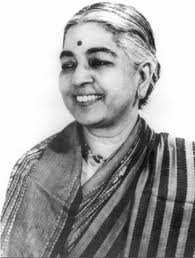In a series of programs that revolve around literature, film, theatre, dance that celebrates work of women in conjunction with International Women’s Month, a 40 minute long documentary film on the life of theosophist, Bharatanatyam dancer and founder of Kalakshetra entitled “The world about us†was recently screened in Hyderabad, India. This documentary film was shared by noted Indian dance critic Shri Sunil Kothari from his private collection of art films.
Rukmini Devi was born more than a century ago, on February 29, in the year 1904. The documentary film on Rukmini Devi featured the journey of her life from a young girl who was so fascinated by Bharatanatyam that she wanted to learn it and master it. She not only achieved what she wanted to but went on to becoming a celebrated authority on dance, music and culture. She was given an opportunity to become the president of India by the prime minister at that time, Shri Morarji Desai . She politely declined the offer by simply saying “I would be better off as an ambassador who protects dance, music art and culture of our country.â€
In a brilliant mélange of video footage featuring the beautiful Kalakshetra campus located 80 kms from Chennai, insightful interviews with the founder Rukmini Devi, administrator - Dr. Shankar Menon, teacher-Sharada Hoffman and international students from countries such as Germany and United Kingdom the film had a powerful impact on viewers.
Aspects ranging from the history of the art form to the daily routine of students built around music and dance learning and practice sessions, theology lessons, recreational sport and yoga sessions formed the core of the film.
Bharatanatyam uses synchronized movements of different parts of the body such as eyes, limbs, head, neck, torso, waist, and legs to tell a story and requires years of systematic training and disciplined practice. Sharada Hoffman, one of Rukmini Devi’s prime disciples and teacher at Kalakshetra says “Dance opens up our inner nature, our spiritual psyche, our higher nature which is a sensitive and beautiful oneâ€.
According to Rukmini Devi, stigma was attached to Bharatanatyam dance art form due to the fact that it was practiced by Devadasis (brides of GOD). It almost disappeared to exist in temples at one time. Rukmini Devi was a pioneer in bringing an awareness of the art form to the domain of interest of the common man. She also departed from tradition in the early 1900s by marrying a famous educationist who was from Ireland.
Rukmini Devi was a powerhouse of energy. She not only taught dancing but choreographed several dance dramas that revolved around mythological stories such as Goddess Lakshmi’s search for a life partner. She also gave refuge to musicians who were suffering due to lack of patronage from rulers and government at Kalakshetra. She connected at a personal level with her students who came from different parts of the world, from a variety of religions and socio-economic backgrounds.
The film had a poignant ending. It featured the journey of a young student from initiation into dance all the way to her debut recital in front of an invited audience after several years of learning under her Kalakshetra dance teacher. The student describes her anxieties before her recital. “A lot of people will be looking at me. If they like my performance they will bless me and give me the confidence to dance better.†The narrator of the film says that while the future of the student is in her own hands, but somewhere, the future of the dance institution, Kalakshetra is also in the balance! Rukmini Devi offers anklets and blesses the arangetram student before her debut recital. The student garlands her in return to show her respect and appreciation for what she has learned over the years. The film concludes with a powerful question from Rukmini Devi to the viewers “I have sown the seeds – what else can be done?â€
The classical arts, particularly music and dance are gaining popularity in the U.S. There are several trained musicians and dancers who are imparting training to talented students with great interest and commitment in the Boston area. When teachers train students to give public performances, they invest enormous time and effort in the exercise. Sincere students practice hard to absorb and reflect the training they receive in a proper manner during a stage performance.
Teachers and students have an equal role to play in preserving Indian classical heritage. It is through a process of give and take, that the joy of carrying forth the legacy of our ancient traditions comes to rest on the strong shoulders of teachers and students.

